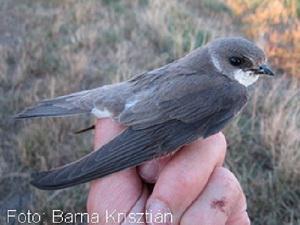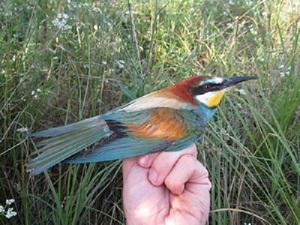Barna Krisztián
Other projects
26 Mar 2013
Active Conservation and Study of the Endangered European Roller (Coracias garrulus) Population in Serbia
The main aim of our project is to map the breeding colonies of Sand martin and European Bee-eater in natural habitats in Vojvodina, to enlarge their possible nesting places by clearing degraded river walls and revitalizing old colonies.

One of the recaptured sand martins.
Sand martins and European bee-eaters are characteristic residents of river walls. Many of them now live in constructed habitats thanks to human activity, here their colonies are threatened by numerous dangers. Their natural nesting places are disappearing due to river regulations. Their numbers show a decrease not only in Serbia but also in other European countries.

European Bee-eater.
Our main aims are to map all of the existing colonies in their natural habitat, especially those nesting in the river walls. We would like to gather the data of all known colonies, those active today and those formerly inhabited. Another aim is to survey the circumstances of the current breeding stock and to ensure the undisturbed nesting as much as we can, so that the number of young birds leaving the nest would be as high as possible. Furthermore, we aim to clear the most important river walls from weed and prevent further weeding, which makes it impossible for the birds to nest in these areas. The protection and preservation of natural habitats is important as there is no human impact, thus this source of danger is minimal. Among our aims is the familiarization of these species with society and emphasizing the protection of their breeding colonies. We would also organizing ringing campaigns, ringing camps. Many people can join these campaigns, which serve as publicizing and popularizing opportunities. Through ringing, recapturing and encompassment of the birds we can form a clear picture of the migration paths that nesting and hatched birds use. This helps us gather information about the percentage of birds returning to their previous breeding areas, the size of dispersion or survival rate, etc.
Through our surveys and project we can size up the population which breeds on these types of habitats, as well as the size and dispersion of nesting places and the factors posing greatest danger to the species.